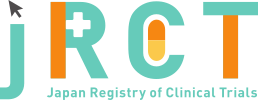臨床研究等提出・公開システム
|
Mar. 06, 2019 |
|
|
Mar. 31, 2022 |
|
|
jRCTs031180191 |
The clinical trial to evaluate the efficacy of [11C]K-2 in refractory epilepsy patients undergoing anterior temporal lobectomy |
|
The clinical trial to evaluate the efficacy of [11C]K-2 in epilepsy patients |
|
Feb. 28, 2020 |
|
8 |
|
FAS 1 7 participants: male 2 (28.6%) / female 7 (71.4%), median age 43y.o. (21-58), seizure type complex partial seizure 5 (71.4%) / complex partial seizure + others 2 (28.6%) |
|
8 participants registered, 4 completed, 4 not completed From March 2017 to Dec 2018, 8 participants were registered. All patients underwent preoperative AMPA-PET examinations, followed by epilepsy surgery. 4 participants discontinued prior to second AMPA-PET examinations. In one of them, the operation plan was changed immediately before surgery, leading to insufficient collection of surgical specimen, hence the discontinuation of the study. One of them was discontinued because of severe seizures several months after the operation, which resulted in irreversible impaired consciousness. One of them was discontinued because of hepatic dysfunction unrelated to study treatment. One of them was discontinued because of the patients issues. The main analyzes were performed on 7 cases in which a sufficient amount of surgical specimens were collected. |
|
Adverse reaction related to study treatment were found 1 subject, Grade 1 high blood pressure (n=1) and Grade 1 headache (n=1). |
|
Primary endpoint was the correlation between preoperative AMPA-PET imaging values (AMPA receptor density) and AMPA receptor biochemical quantification values (protein expression levels) in the same brain regions, and the correlation coefficient was calculated by the least squares method of the regression line. Using SUV, the correlation coefficient was 0.846 (90% CI = 0.418 - 0.958), and using BPnd imaging values, the correlation coefficient was 0.891 (90% CI =0.557 - 0.970). The following items were examined as secondary analysis. 1. Summary of postoperative seizure evaluation using classification of Engel classification and ILAE classification : No significant changes were observed in PET image values before and after surgery in comparison between patients showing seizure free and seizure remaining postoperatively. 2. Summary of preoperative AMPA receptor density classified by increase, unchanged, or decrease in postoperative antiepileptic drugs (number of oral medications and daily dose) : No change in preoperative AMPA receptor density was observed by each classification. 3. Summary of changes between preoperative values of AMPA receptor density obtained from [11C]K-2PET images of each unresected region (hippocampus/temporal lobe cortex region) on the resection side and those obtained at 6 to 12 months after surgery : The changes were -0.8835 to 0.0818 in SUV and -0.6988 to 0.1030 in BPnd, and in both cases, the AMPA receptor density did not change significantly before and after surgery. 4. Correlation between FDG-PET measurement values and preoperative AMPA receptor densities : The correlation coefficient of SUV showed a high negative correlation of -0.525 to -0.891. This result indicates the higher the AMPA receptor density, the lower the FDG-PET image value. 5. Correlation between changes in cognitive test values (intelligent test IQ, memory test MQ) and preoperative AMPA receptor densities obtained from [11C]K-2PET images : A positive correlation was found between verbal IQ and AMPA receptor density in the inferior temporal gyrus, and functional IQ and AMPA receptor density in the fusiform and middle temporal gyrus. In memory tests, following evaluation items showed positive correlation with AMPA receptor densities in indicated regions; verbal memory and middle temporal gyrus, attention/concentration and hippocampus, delayed regenerative ability and fusiform/middle temporal gyrus, general memory and middle temporal gyrus. |
|
In the primary endpoint, we examined the specificity of AMPA-PET in the human brain and the correlation coefficient between the amount of AMPA receptor protein expressions in the surgical specimen and AMPA receptor densities showed a high value of 0.846 or 0.891. These results sugeest that AMPA receptor densities in the living human brain can be measured with high quantitativeness by AMPA-PET. [11C]K-2PET was generally safe. |
|
Mar. 31, 2022 |
|
No |
|
None |
|
https://jrct.mhlw.go.jp/latest-detail/jRCTs031180191 |
Miyazaki Tomoyuki |
||
Yokohama City University Hospital |
||
3-9 Fukuura, Kanazawa-ku, Yokohama, Kanagawa, Japan |
||
+81-45-787-2579 |
||
johney@yokohama-cu.ac.jp |
||
Sano Akane |
||
Yokohama City University, School of Medicine |
||
3-9 Fukuura, Kanazawa-ku, Yokohama, Kanagawa, Japan |
||
+81-45-787-2579 |
||
akane@med.yokohama-cu.ac.jp |
Complete |
July. 20, 2016 |
||
| Mar. 27, 2017 | ||
| 8 | ||
Interventional |
||
single arm study |
||
open(masking not used) |
||
uncontrolled control |
||
single assignment |
||
other |
||
1.refractory epilepsy patients(mesial temporal lobe epilepsy) |
||
1.patients who have significant abnormalities insides the brains |
||
| 20age old over | ||
| No limit | ||
Both |
||
refractory epilepsy patients |
||
Administration of unapproved drug |
||
The correlation of the AMPA receptors densities examined by biochemical study and [11C]K-2 PET study |
||
Efficacy |
||
| Translational Research Network Program | |
| Not applicable |
| Yokohama City University Certified Review Board | |
| 3-9 Fukuura,kanazawa-ku,Yokohama,Kanagawa, Kanagawa | |
+81-45-370-7627 |
|
| rinri@yokohama-cu.ac.jp | |
| Approval | |
Jan. 18, 2019 |
| UMIN000025090 | |
| UMIN Clinical Trials Resistry |
none |
